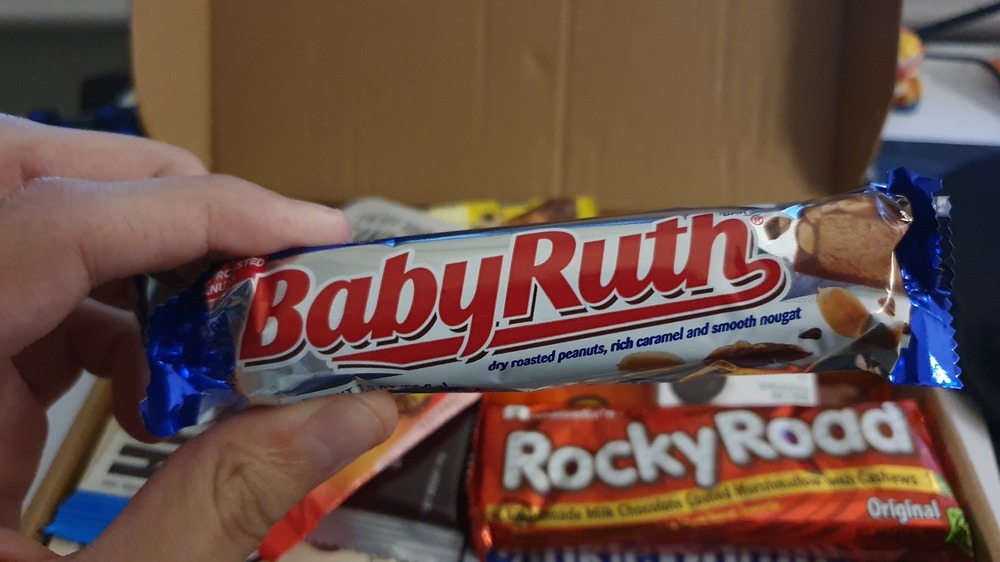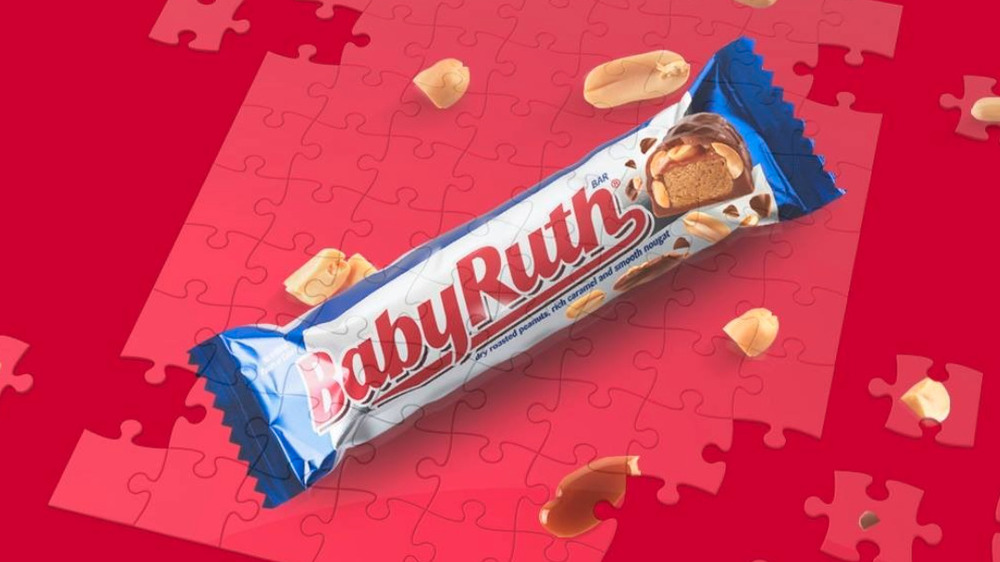The Untold Truth Of Baby Ruth
Fans of nutty, chewy, and chocolate-y Baby Ruth bars love them as they are, and as an ingredient to some of the best chocolate desserts you'll ever taste. Apart from the nation's taste buds, the candy bar has rocked our culture in a number of subtle ways, from its status as cult classic Butterfingers' older brother to its appearances in movies like The Goonies, Caddyshack, and Hellboy (2004). Its taste is so intertwined with the everyday American experience that you can probably imagine the sensation of eating one just by reading these words.
But what do you really know about Baby Ruth? The classic candy bar's taste and package might be extremely familiar, but its history may very well be another matter. Baby Ruth has a lot of history behind it, and many parts of that history fly considerably higher than you might expect — sometimes literally. Let's take a moment to look into the untold truth of Baby Ruth.
The marketing genius behind Baby Ruths
To truly appreciate the history of Baby Ruth is to know the man who invented them. His name was Otto Young Schnering, and as the Candy Hall of Fame tells us, he wasn't what you'd expect from an early 20th century business magnate. A philosophy graduate from the University of Chicago, he got his start selling pianos for a living, and eventually invested $100 in candy-making gear to start a completely new career.
Schnering's company, Curtiss Candy, started in 1916, and he came up with Baby Ruth four years later. As Mental Floss notes, the product was an updated version of his previous success, Kandy Kake — but while it was delicious, Schnering's real weapon in turning it into a massive success was his considerable marketing savvy. He invested in event sponsoring and created Baby Ruth-themed merchandise, and slashed the product's price to five cents a bar, as opposed to the closest competitor's ten. According to History, he even marketed Baby Ruths as meal replacement-style energy bars.
Although some of this would no doubt raise a few eyebrows today, his thinking was truly groundbreaking in his day and age — to the point that he eventually served as the chairman of the merchandising and advertising committee of the National Confectioners' Association.
The great Baby Ruth rain of Pittsburgh
Imagine walking down the street and minding your own business, when suddenly, your favorite candy bars start raining down. According to Mental Floss, the good people of Pittsburgh — or at least the portion that loved Baby Ruth bars — had this exact experience in 1923, when Curtiss Candy hired a pilot named Doug Davis to drop several hundred Baby Ruths and Butterfingers over the city. For reasons that will soon be extremely obvious, the city of Pittsburgh didn't much care for the promo, especially since the candy drops were accompanied by a number of Davis' wild flying stunts. In fact, this specific method of candy distribution was soon made illegal in the city.
At this point, it's probably worth mentioning that Davis wasn't just throwing crates of Baby Ruths at people from hundreds of feet up in the air — the delicious treats were actually attached to tiny parachutes. Still, while this probably saved a few people from chocolate-y concussions, the company itself freely admitted that the public's natural "hey, free candy!" reflex was more than enough to create chaos. "People risked falls from windows reaching for the parachutes," a company publication described the happy mayhem (via Mental Floss). "Children ran out into the streets (without danger — traffic was hopelessly snarled) and adults fought for the free candy." Don Draper of Mad Men would be proud.
Baby Ruth vs. Babe Ruth
Baby Ruth enthusiasts might have noted the name's similarity to that of George Herman "Babe" Ruth Jr., the biggest baseball superstar of the era the candy bar hails from. As History tells us, the connection between the slugger and the candy is extremely convoluted, and one that the player quite possibly didn't much care for.
When Baby Ruths were created in 1921, there were suspicions that the brand name was the Curtiss Candy company's thinly-veiled attempt to hitch a ride on Babe Ruth's good name without actually paying the man — and the fact that the brand has traditionally been closely tied to baseball certainly seems to support this. Per Mental Floss, Ruth was aware of the connection, but his attempt to score royalties failed.
When the Bambino himself decided to get in on the candy action in 1926 with a candy that was advertised with the slogan "Babe Ruth's Own Candy," it was only to be expected that the two candies were on a legal collision course. However, it was actually Curtiss Candy that filed the lawsuit. According to them, the Baby Ruth bar was actually named after the long-dead daughter of President Grover Cleveland, and Babe Ruth was trying to piggyback on their popularity (via Today I Found Out).
The argument was successful, and in 1931, Babe Ruth lost the right to use his own, established nickname in the candy business ... because it sounded too similar to the candy bar that allegedly lifted its name from him.
The Baby Ruth Flying Circus
Some companies might have decided to take things down a notch after a stunt like the Pittsburgh candy rain, but the Curtiss Candy Company had already turned their aerial assault up to 11. According to Mental Floss, the company had created a full-on aerial Baby Ruth operation called the Baby Ruth Flying Circus. As Aviation Quarterly (via Airport Journals) notes, the Circus' ringmaster was none other than Doug Davis, the pilot who pulled off the Pittsburgh stunt.
The Flying Circus was a massive undertaking. It flew in over 40 states, and Davis had a network of experienced pilots who graced assorted fairs and events with parachute Baby Ruths, to the crowds' delight. This rather literal marketing bombardment did what it set out to do. Davis made a pretty penny from the operation, and in 1928, Baby Ruth became the No. 1 candy bar in the United States.
Baby Ruth's strange connection to the Hiroshima atomic bomb
Unless you have a particularly dangerous peanut allergy, the concepts of "delicious caramel, peanut and chocolate nougat treat" and "the most terrifying weapon mankind has ever built" couldn't possibly be further from each other. Yet, according to Aviation Quarterly (via Airport Journals), the humble Baby Ruth bar and the devastating atomic bomb indeed have a surprising connection.
On one of his Baby Ruth Flying Circus runs in Miami, Doug Davis took a local Baby Ruth distributor's son, Paul, in the air with him, and the kid was responsible for dropping the candy bars as Davis flew. This was young Paul's first time in an airplane cockpit, but far from the last one. His full name was Paul Tibbets, and he went on to make history in Aug. 6, 1945 ... when he piloted Enola Gay, the U.S. military bomber that dropped the atomic bomb on Hiroshima.





